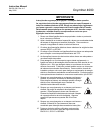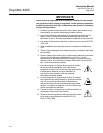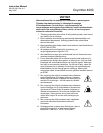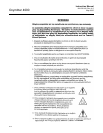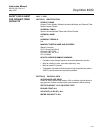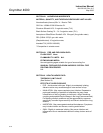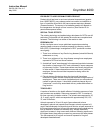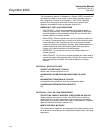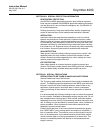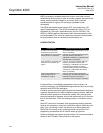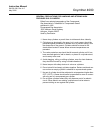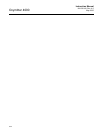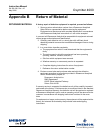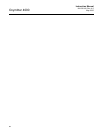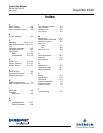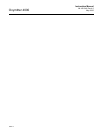
Instruction Manual
IM-106-340, Rev. 4.0
May 2006
A-19
Oxymitter 4000
SECTION VIII. SPECIAL PROTECTION INFORMATION
RESPIRATORY PROTECTION
Use NIOSH or MSHA approved equipment when airborne exposure
limits may be exceeded. NIOSH/MSHA approved breathing equipment
may be required for non-routine and emergency use. (See Section IX
for suitable equipment).
Pending the results of long term health effects studies, engineering
control of airborne fibers to the lowest levels attainable is advised.
VENTILATION
Ventilation should be used whenever possible to control or reduce
airborne concentrations of fiber and dust. Carbon monoxide, carbon
dioxide, oxides of nitrogen, reactive hydrocarbons and a small amount
of formaldehyde may accompany binder burn off during first heat. Use
adequate ventilation or other precautions to eliminate vapors resulting
from binder burn off. Exposure to burn off fumes may cause respiratory
tract irritation, bronchial hyper-reactivity and asthmatic response.
SKIN PROTECTION
Wear gloves, hats and full body clothing to prevent skin contact. Use
separate lockers for work clothes to prevent fiber transfer to street
clothes. Wash work clothes separately from other clothing and rinse
washing machine thoroughly after use.
EYE PROTECTION
Wear safety glasses or chemical worker's goggles to prevent eye
contact. Do not wear contact lenses when working with this substance.
Have eye baths readily available where eye contact can occur.
SECTION IX. SPECIAL PRECAUTIONS
PRECAUTIONS TO BE TAKEN IN HANDLING AND STORING
General cleanliness should be followed.
The Toxicology data indicate that ceramic fiber should be handled with
caution. The handling practices described in this MSDS must be strictly
followed. In particular, when handling refractory ceramic fiber in any
application, special caution should be taken to avoid unnecessary
cutting and tearing of the material to minimize generation of airborne
dust.
It is recommended that full body clothing be worn to reduce the potential
for skin irritation. Washable or disposable clothing may be used. Do not
take unwashed work clothing home. Work clothes should be washed
separately from other clothing. Rinse washing machine thoroughly after
use. If clothing is to be laundered by someone else, inform launderer of
proper procedure. Work clothes and street clothes should be kept
separate to prevent contamination.
Product which has been in service at elevated temperatures (greater
than 1800°F/982°C) may undergo partial conversion to cristobalite, a
form of crystalline silica. This reaction occurs at the furnace lining hot
face. As a consequence, this material becomes more friable; special
caution must be taken to minimize generation of air-borne dust. The
amount of cristobalite present will depend on the temperature and
length in service.



